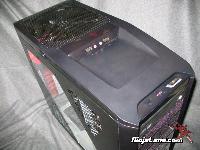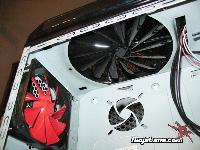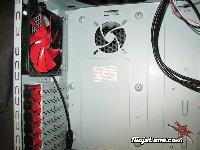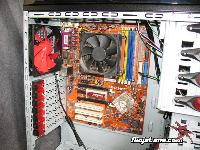After careful consideration I have decided to transfer all hardware review activities to a new domain. I purchased Hardwareasylum.com in 2012 and have been working hard to build a new and improved Ninjalane on that domain. If you are reading this you have reached one of the archived articles, news, projects and/or reviews that were left behind during the site migration.
Please update your bookmarks and be sure to visit the new and improved Ninjalane at Hardwareasylum.com
Thermaltake V9 Case Review
Author: William West
Published: Wednesday, October 22, 2008
Case Features & Layout
One of the most unique and dominate feature of the V9 is the huge 230mm fan on the top of it. There is also the very sleek power and reset buttons on the top front of the Thermaltake V9. Plus you get a spot to lay your MP3 Player on the top of the V9 while it is using the USB connection. While we are looking on the port at the top we can see two USB 2.0, Audio In, and a Microphone In.
Looking up at the 230mm fan from the inside you get a good impression of just how big it is. Also take note of the thinner blades on the 230mm fan. While we are here you can also see the 120mm exhaust fan with its cool red blades. The Thermaltake V9 is all about getting attention.
With all of these fans you get great air flow to keep your temps down. This is a great part of a more valued oriented case that still allows for higher speed PC parts without having to worry about the thermal conditions to much.
With all of these fans you get great air flow to keep your temps down. This is a great part of a more valued oriented case that still allows for higher speed PC parts without having to worry about the thermal conditions to much.
Moving down to the motherboard area you will find very little room to work with. This is still not a huge concern since we are looking at a lower budget case with a normal foot print.
Thermaltake does give you an option to add a small 70mm x 10mm fan to cool the back of the motherboard right behind where CPU socket is normally located.
Thermaltake does give you an option to add a small 70mm x 10mm fan to cool the back of the motherboard right behind where CPU socket is normally located.
Here we have a regular ATX motherboard installed on the six humps, and three standup mounts. You'll notice that you are only going to be able to use either a Regular or Micro ATX motherboard as there is no room for a server type board what so ever.
Even with a full ATX board you have enough room to run cables on a zip tie management system right next the board. With this being a smaller case cable management will be of the highest priority. Without good cable management the big air flow fans are not doing you any good.
Even with a full ATX board you have enough room to run cables on a zip tie management system right next the board. With this being a smaller case cable management will be of the highest priority. Without good cable management the big air flow fans are not doing you any good.





